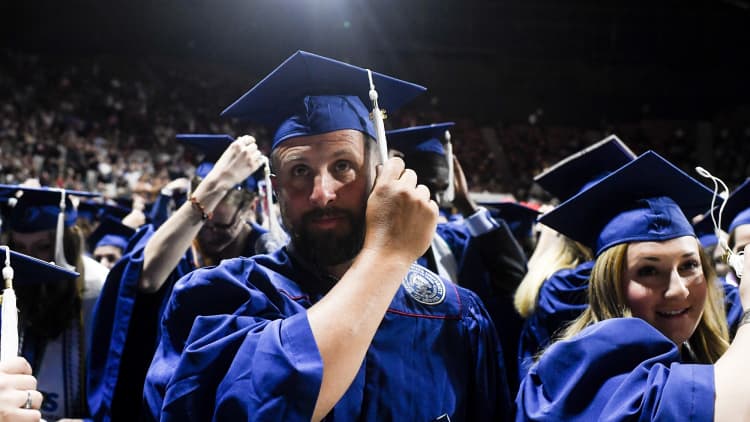Each year, roughly 2 million college graduates earn bachelor's degrees in the U.S., and for good reason.
The Bureau of Labor Statistics reports that Americans with a bachelor's degree have median weekly earnings of $1,173, compared to just $712 a week for those who have a high school diploma.
And while the number of students earning bachelor's degrees has steadily increased over the past several decades, so has the number of students earning professional certificates and associate's degrees.
In fact, according to new report titled "The Overlooked Value of Certificates and Associate's Degrees: What Students Need to Know Before They Go to College" from the Georgetown University Center on Education and the Workforce, just as many students are earning an associates degree or professional certificate as those who are earning a traditional bachelor's degree.
Around 50% of undergraduate students nationwide are enrolled in certificate and associate's degree programs, and 47% are enrolled in bachelor's degree programs.
Courtesy of The Georgetown University Center on Education and the Workforce
That said, not all associate's degrees and professional certificates set up students for professional success, and a bachelor's degree remains the "gold standard" for stable employment and lifetime earnings, say researchers.
The researchers who wrote Georgetown's report stress that there is a wide range of earnings among those with associate's degrees and professional certificates.
"Field of study matters most when it comes to certificates and associate's degrees," says Dr. Anthony P. Carnevale, lead author and CEW director.
For instance, Carnevale and his team found earning a certificate in engineering technologies, which can lead to a job as a technician on a construction, manufacturing or engineering team, can lead to median earnings between $75,001 and $150,000, while workers with certificates in cosmetology and education report median earnings closer to $20,000.
Courtesy of The Georgetown University Center on Education and the Workforce
Courtesy of The Georgetown University Center on Education and the Workforce
Professional certificate and associate's degree programs are often directly linked to career paths. According to the report, roughly 94% of certificates and 57% of associate's degrees are awarded in career-oriented fields.
This direct career pathway is a key part of what can make an investment in an associate's degree of professional credential pay off.
According to Carnevale's research, graduates who work a job related to their certificate program report higher median earnings (between $40,001 and $50,000) than those who are not (between $20,001 and $30,000).
"The new rules of the college and career game confirm that education level matters, and that more education is generally better when it comes to earnings potential," reads the report. "What is less well known is that program of study and major matter even more to potential earnings than education level."
Most associate's degrees and professional certificates are earned at public two-year colleges, often known as community colleges, where costs are relatively inexpensive compared to traditional four-year colleges.
According to the College Board's 2018 Trends in College Pricing Report, tuition at public two-year schools is about $3,660 on average, per year, for full-time students.
But in reality, many students end up paying far less in tuition. Published tuition costs do not account for scholarships, grants and tax benefits. The College Board broke down what the average net price of college is today — taking scholarships and grants into account — and found that students typically pay less than the published price.
In fact, according to the College Board, "56% of independent students and 50% of dependent students at public two-year colleges did not pay any part of their tuition and fees." Overall, more than half of community college students received enough grant aid to cover their tuition and fees.
Like this story? Subscribe to CNBC Make It on YouTube!
Don't miss:



